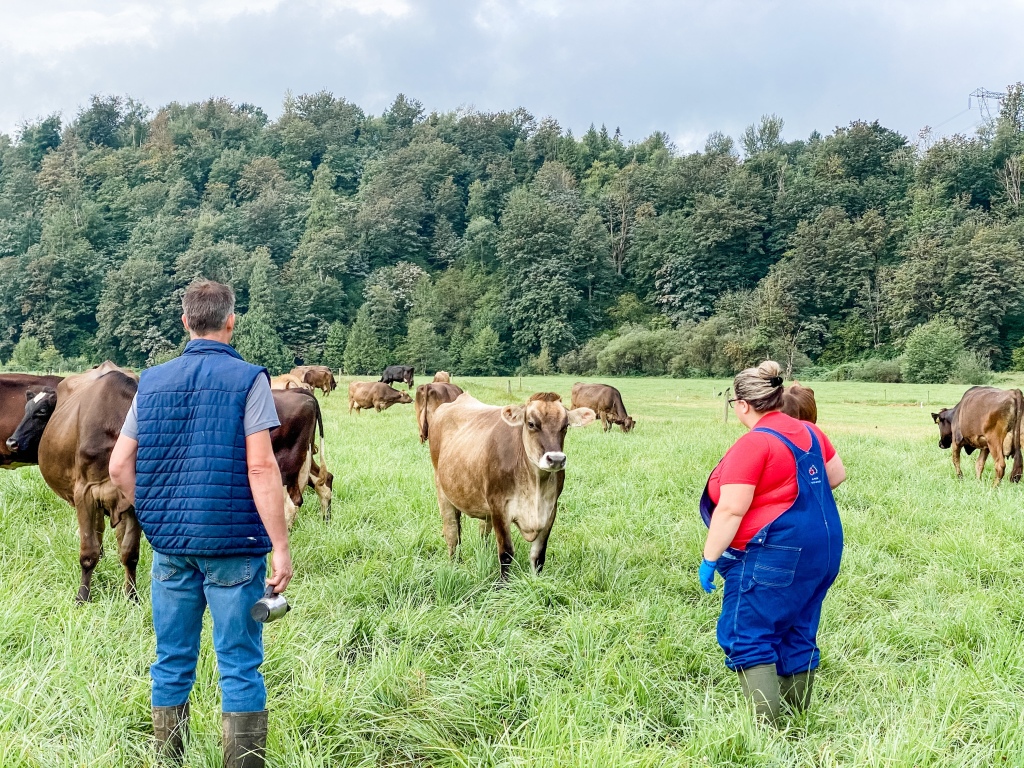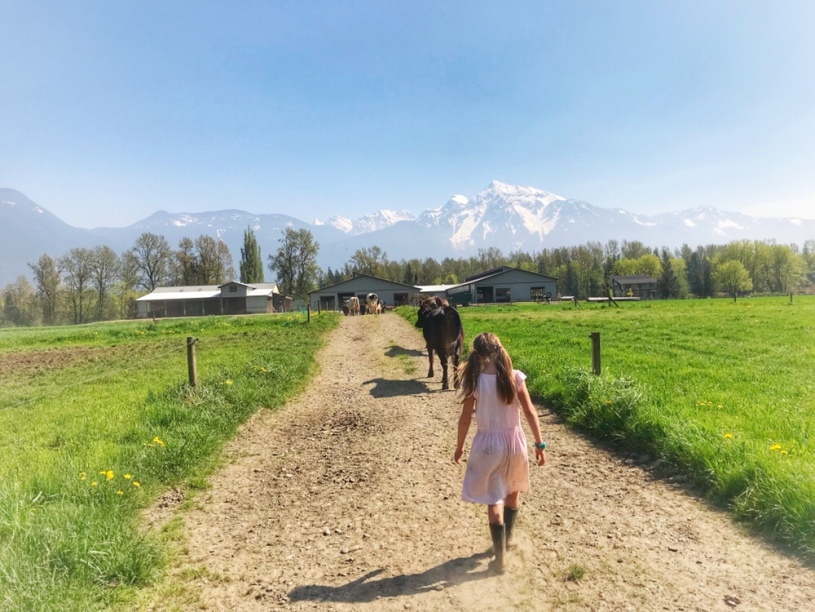A large part of a dairy farmer’s day is spent milking the cows. Each farm in Canada follows similar procedures, and all must adhere to the regulations set out in the Canadian Quality Milk (CQM) program. On our farm, we usually milk the cows ourselves; our 70 cow milking herd is easily managed by one person. We do, however, employ a lovely young lady who milks our cows on alternating Saturday afternoons. This gives us some time to spend as a family, either around the house or occasionally taking day trips together. We milk twice a day – beginning at 5:30 am and 5:00 pm – and each milking takes about one hour, excluding the associated chores, such as feeding calves and heifers. It takes about 8 minutes to milk each cow, some shorter, some longer. Each side of our milking parlour (the place where the cows are milked) accommodates 8 cows, so 16 cows are milked at once. The rest of the day, our cows are free to roam about the barn, socialize with other cows, lie down in the comfy sawdust bedded stalls, munch on their specialized ration of feed at the feed bunk or head out to pasture during the growing season.
We’ve compiled a few photos recently that document our milking procedures. Enjoy!

Near milking time, the cows start to gather around the milking parlour, eagerly anticipating the moment that we will open the gate allowing them access to the parlour. About half an hour before we are scheduled to milk, the parlour equipment that comes into contact with the milk is automatically washed and sanitized. This ensures that the equipment is sterile before contact with milk, keeping it safe for consumer consumption. Of course, milk is also pasteurized at the processing plant to totally eliminate the chance of milk-borne bacteria making a consumer ill. Once the gate is opened, the cows amble into the parlour. We always treat our cows gently and calmly, but this is especially important at milking time. Cows that are stressed or agitated will not allow their milk to drop, stress and agitation can block the milk let-down reflex. A cow that is not milked out properly will experience pressure and fullness in her udder before she is due to be milked again. Repeated episodes of improper milking may lead to an infection of the udder, mastitis. Therefore, both we and our employee know that cows must be handled in a calm and quiet manner during milking. Our cows are accustomed to our parlour layout, and align themselves at a 45 degree angle to the parlour pit. Our parlour is laid out in para-bone style, a cross between parallel (milking between the back legs) and herringbone (milking from the side of the cow) styles. We attach the milking unit between the cow’s hind legs. When the cows have all moved over into the waiting area in the alley behind the milking parlour, we take a scraper and clean the manure or wet sawdust out of each stall, and spread more sawdust from the pile at the front of the stall into the area where the cows lie. We want our cows to be comfortable while they’re lying down producing more milk, and overall cow health is improved when cows lie comfortably as well.
Once all 8 cows have positioned themselves properly, the back gate is closed and the brisket bar at the cows’ chest height moves in toward the parlour pit, ensuring that the cows cannot move around too much and possibly injure themselves or their neighbor. We designed special water troughs on the brisket bar that are filled with lukewarm water from the plate cooler (the plate cooler quickly cools the milk before it is pumped to the bulk tank). The girls often enjoy slurping down some liquid as they are being milked. Many cows also contentedly chew their cud while being milked; the milking process is comfortable, even pleasurable for a dairy cow.
Before a cow can be milked, her udder and teats must be cleaned of manure splatters and sawdust shavings. We use soft microfiber cloths for this (see photo above). The gentle process of cleaning the udder also stimulates milk production. Some farms also use a pre-dip that disinfects the teats. We have had great success with just using our towels. Notice on the photo above that the cow’s udder is relatively clean. We take care to ensure that our cows’ stalls are free from manure and that the walking surfaces of the barn are scraped multiple times per day. As a result, less manure is present on the udder, making the pre-milking cleaning much easier. A clean udder also results in more sanitary milk.
After waiting a few moments after wiping to allow the cow to get into the “milking moooo-d”, we attach the milking unit. A milking unit claw has 4 attachments – a specialized cup fitted with a soft, flexible rubber inflation – that are attached to each teat on the udder. Our units only produce suction when they are held upright. This eliminates the chance of manure or urine being drawn into the milking equipment should the cow kick off the machine or if it should fall to the ground. The suction produced is gentle but insistent, mimicking the actions of a calf’s mouth as it suckles from a teat. Milk begins to flow into the inflation, through the pipes to the plate cooler, then onto the bulk tank. If, for some reason, a cow has been treated with antibiotics, the hoses linking the milking unit to the pipeline that connect to the bulk tank are removed, and the milk is collected in a large bucket and discarded until the required withdrawal time has passed. The withdrawal time is drug specific, and is the period of time necessary for the last residues of the drug to be excreted from the cow’s system. Milk is tested on farm and at the processing plant to ensure that no antibiotic residues are present in milk. If the milk tested is found to contain antibiotic residues, the whole truck load of milk will be discarded and the farm responsible must pay a hefty fine.
It usually takes about 5-10 minutes for each cow to finish milking. Once the sensors in the milking unit register that milk has stopped flowing, the milking unit automatically detaches from the udder. Each milking unit also measure how much milk each cow produces. This cow produced 15.9 liters at this particular afternoon milking. Cows generally produce a little more milk in the morning. This cow produces about 34 L of milk daily. Brown Swiss and Brown Swiss cross bred cows generally produce a little less milk than their Holstein counterparts, but the butterfat and protein components in their milk are higher. Our herd average butterfat currently is 4%, and the protein content is as 3.46%.
After the machine detach, each teat is dipped in an iodine solution. The iodine helps to ensure that no bacteria will enter the still slightly open teat end, and also conditions the skin of the teat, keeping it smooth and supple, free of cracks and dryness.

In the photo below, you can notice the difference in udder size, comparing before and after the cow has been milked. 
Once the entire row of cows has finished milking and all of the teats have been post-dipped, the front gate of the parlour is opened and the cows can return to the barn. The cows all head over to the feed bunk to enjoy a meal of their specially prepared mixed ration. After all, producing milk works up a good appetite!

When the entire herd has been milked, the manure piles are scraped away and the parlour floors, wall, and equipment are thoroughly sprayed down with a high pressure hose. The milking equipment is sanitized and washed once again. The milk in the bulk tank is cooled and stirred until the milk truck comes to pick it up and delivers it to the processor. From there, it is pasteurized and packaged and sent to local grocery stores for consumer enjoyment.

After we feed the calves warm milk in bottles and nipple buckets, we check the other young stock to be certain they also have enough food and are comfortable, then finally head into the house for our own dinner. And on some nights, we’re lucky enough to enjoy a view like this:

Now, the next time that you enjoy a glass of cold milk, a wedge of cheese, a serving of yoghurt, you’ll know exactly how the product you are enjoying was supplied by cows like ours to satisfy your hunger and cravings. And so, our girls and our family would just like to say: “You’re Welcome!”
































